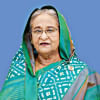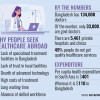Capacity enhancement is the need of the hour

The innovative model of "community clinics," introduced in Bangladesh by the Awami League government in 1998, has been recognised by the United Nations as a unique example of public-private partnership in the health sector. As part of global recognition of the efficacy of community-based healthcare in the country, the UN resolution, titled "Community-based primary health care: a participatory and inclusive approach to universal health coverage," was unanimously adopted on May 17, 2023.
While introducing the "Community Clinic Model of Bangladesh," the resolution asked member-states to explore measures to scale up, stressing that "the implementation of the resolution can make a world of difference to the lives of billions of people around the world who need basic healthcare facilities closest to their homes." It also acknowledged women's empowerment, community engagement and mobilisation towards achieving universal access to health.
This morale-boosting UN resolution, a veritable recognition of the hard work put in by thousands of health assistants, family welfare assistants, midwives and health staff at grassroots level for over two decades, will no doubt inspire them to make the community clinics even more people-friendly, offering essential primary healthcare services.
The clinics operate on the basis of a public-private partnership agreement. Under this agreement, the government provides structural services, medicines, service providers (CHCP, HA and FWA) and other logistical support. The local communities, on the other hand, donate land for the construction of clinics and ensure the overall safety and security.
It is now widely acknowledged that community clinics are the first frontier from where our fight to reduce child and maternal mortality, arrest malnutrition, provide antenatal care to pregnant women, organise vaccination drives, etc begins. Hosne Ara (not real name), an expecting mother, said in an interview, "I stay in a village which is located in a hilly area. It is not possible for me, in my present condition, to go to the town for availing health services. But now we receive these health services in our village at the community clinic." This, in a nutshell, is the kind of services women in distant villages are getting from community clinics.
We believe that community clinics can play a major role in reducing the child mortality rate, which is on the rise at the moment. A study report published by Bangladesh Bureau of Statistics (BBS) on June 13 says that in 2021, under-five child mortality rate was 28 per thousand. But it increased to 31 in 2022. And deaths of children under one year has increased to 25 per thousand from 22 per thousand during the same period.
Though community clinics proved to the world that it's a model that can deliver desired healthcare services at the grassroots, they were shut down with the change of government in 2001. In 2009, they were revived through a project titled "Revitalisation of Community Health Care Initiatives in Bangladesh (RCHCIB)."
While we appreciate the government giving full attention towards the restoration and revamping of community clinics by adding important features, we feel the concept of public-private partnership needs to be emphasised further and explained elaborately among the rural populace for better maintenance of the clinics.
Since most of the over 20-year-old buildings are now in a dilapidated state, each community clinic must be housed in a spacious new building with better storage facilities for medicines and equipment. Efforts should also be undertaken to create the sense of ownership among the locals to make community clinics sustainable and equitable. No doubt, this is an ideal way to universalise healthcare in Bangladesh, but it will need continued allocation of resources and full political commitment.
The beneficiaries must not consider the clinics as mere medicine shops and thus take undue advantage of them. If medicines for diabetes and non-communicable diseases are made available, it has to be ensured that these medicines are given only against genuine prescriptions. Qualified manpower has to be posted there to stop pilferage and monitor the inflow of medicines and proper use of medical equipment. There is a shortage of medical equipment in most community clinics, and many of the outdated ones do not function properly. These need to be replaced immediately by new supply so diagnosis can be accurate and easy.
Since hundreds of people visit a clinic every day, cleanliness of the premises is an important factor that has to be addressed regularly, especially when infectious diseases are coming in full fury and taking lives.
The role of community healthcare providers (CHCP) is important for the smooth functioning of a community clinic, but there are allegations that many of them are not qualified and trained enough to handle even common ailments. They, therefore, need to attend regular training courses to upgrade their skills.
Absence of CHCP, HA and FWA during rush hours is a common complaint at many clinics. Patients coming from far-off villages on foot will feel frustrated if they fail to find anyone at the clinic. Community leaders and senior district health officials must address this issue and search for a suitable answer.
Some senior health experts are of the opinion that the government should appoint at least one registered doctor at every community clinic to provide minimum healthcare. If implemented, we believe this would take rural healthcare service towards fulfilling our goal of Health for All. But in reality, the pertinent question of whether a qualified doctor would like to stay in a remote village for months would come up eventually. We have seen that qualified doctors are reluctant to stay even in upazila health complexes for long.
We believe that community clinics can play a major role in reducing the child mortality rate, which is on the rise at the moment. A study report published by Bangladesh Bureau of Statistics (BBS) on June 13 says that in 2021, under-five child mortality rate was 28 per thousand. But it increased to 31 in 2022. And deaths of children under one year has increased to 25 per thousand from 22 per thousand during the same period.
In this regard, regular and timely interaction among the community people and community clinic healthcare providers will help in creating awareness regarding childhood diseases, importance of vaccination against killer diseases and urgency of timely intervention to reduce child mortality rate in the country.
There is no denying that community clinics have all the promises to save lives if run by qualified people. They will need full support of the government in terms of funding and manpower. At the same time, the community stakeholders must participate with the zeal of ownership.
Shahnoor Wahid is a senior journalist.
Noushin Mouli Waresi works at Bangladesh Health Watch, Brac James P Grant School of Public Health.

 For all latest news, follow The Daily Star's Google News channel.
For all latest news, follow The Daily Star's Google News channel. 









Comments